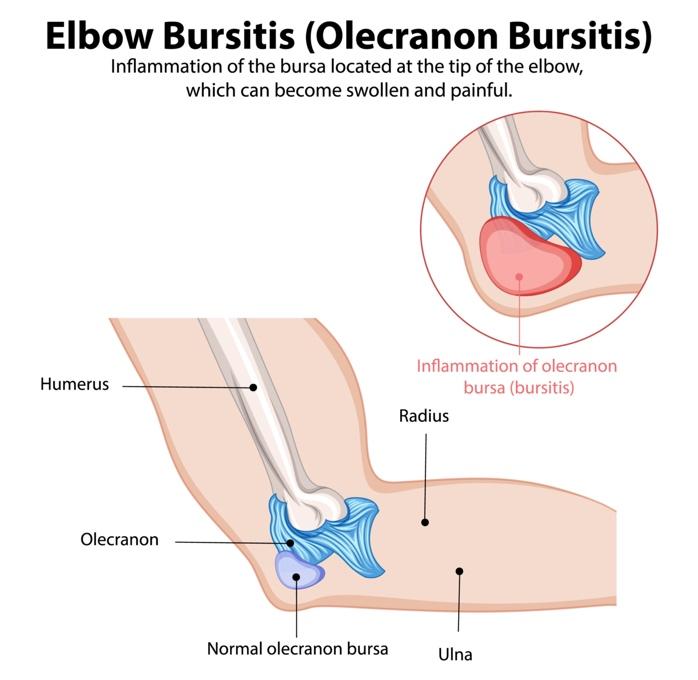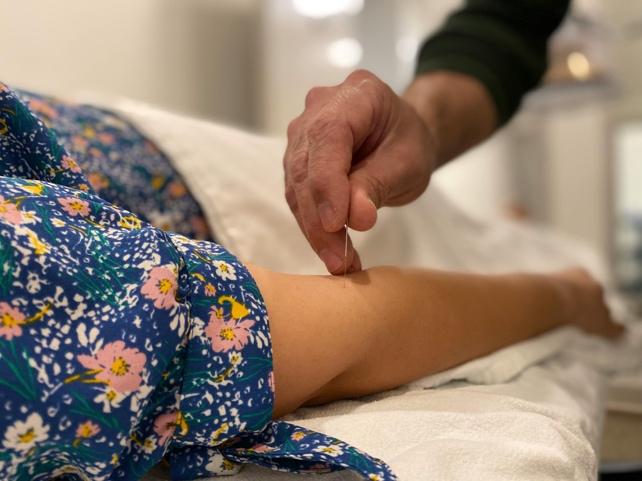Chiropractic care in NYC helps relieve elbow bursitis pain and can promote faster recovery
Do you ever notice swelling or discomfort at the tip of your elbow and wonder what’s causing it?
Elbow bursitis, also known as olecranon bursitis, could be the reason. This condition occurs when the small, fluid-filled sac (bursa) at the back of your elbow becomes inflamed. While it’s often mild, elbow bursitis can lead to noticeable swelling, discomfort, and even pain, making it difficult to perform everyday activities. Let’s explore what causes this condition, how to recognize its symptoms, and what you can do to manage it effectively.
Understanding Elbow Bursitis (Olecranon Bursitis)

Elbow bursitis, also known as olecranon bursitis, is an inflammation of the bursa located just behind the bony tip of the elbow (olecranon). The bursa is a fluid-filled sac that allows the elbow to move smoothly without friction. When inflamed, it can lead to noticeable swelling and discomfort.
Anatomy of the Elbow
If you bend your arm and touch your elbow, the bony point you feel at the tip of your elbow is the olecranon. The olecranon bursa is located between that point (the olecranon) and the skin. This bursa is thin and filled with fluid, which helps cushion the elbow bone, assisting the skin in moving smoothly and reducing any friction over the bone when you bend or move your elbow.
What are the Symptoms of Elbow Bursitis?
People with olecranon bursitis often notice the following symptoms:

- Swelling: The most noticeable symptom is a visible swelling at the back of the elbow, which can vary in size from small to as large as a golf ball.
- Pain: While some cases may be painless, others experience pain, especially when bending the elbow or applying pressure to it.
- Warmth: The affected area may feel warm to the touch.
- Redness: The skin over the swollen area might appear red, particularly in cases of infection.
- Limited range of motion: The condition can make it difficult to fully bend or straighten the elbow.
- Tenderness: The swollen area may be tender to touch, especially if infected.
In cases of septic (infected) olecranon bursitis, additional symptoms may include:
- Fever
- Increased pain and redness
- Spreading redness and swelling beyond the elbow area
It’s important to note that symptoms can vary in severity, and some individuals may experience only swelling without significant pain or discomfort
What Causes Elbow Bursitis?
There are several reasons someone might develop elbow bursitis:
- Trauma: A direct injury to the elbow can cause bleeding and inflammation in the bursa, leading to swelling.
- Inflammatory Conditions: Diseases like rheumatoid arthritis, gout, and psoriatic arthritis can increase the risk of bursitis.
- Infections: Small cuts or injuries can allow bacteria to enter the bursa, leading to an infectious form of bursitis.
- Chronic Conditions: Diabetes, alcoholism, or long-term kidney treatments like dialysis may also contribute.
- Repetitive Pressure: Certain occupations or activities, like leaning on elbows frequently, can irritate the bursa over time.
Comparing Elbow Bursitis with Other Conditions
Let’s examine how elbow bursitis differs from tennis elbow, cellulitis, and gout. Understanding the differences can make determining what’s causing your symptoms easier and what to do next.
Elbow Bursitis vs. Tennis Elbow
Both elbow bursitis and tennis elbow cause discomfort in the elbow area and can result from overuse. However, they differ in their underlying causes. Elbow bursitis occurs when the bursa, a fluid-filled sac near the elbow, becomes inflamed. In contrast, tennis elbow, or lateral epicondylitis, involves inflammation or damage to the tendons around the elbow joint.
Elbow Bursitis vs. Elbow Cellulitis
Elbow cellulitis is a bacterial infection that affects the skin and deeper tissues, leading to swelling. While both cellulitis and bursitis can cause noticeable swelling near the elbow, bursitis stems from inflammation of the bursa and isn’t typically infectious unless septic bursitis is present.
Elbow Bursitis vs. Gout
Gout is a type of arthritis caused by excess uric acid in the body, leading to the formation of sharp crystals in the joints. While both conditions cause pain and swelling, gout commonly affects the big toe but can also involve other joints, including the elbow. The swelling in gout is due to crystal buildup, whereas bursitis is caused by inflammation in the olecranon bursa.
If you experience persistent pain or swelling in your elbow, it’s important to consult a healthcare provider for proper evaluation and care.
How is elbow bursitis treated?
Treating elbow bursitis typically starts with simple steps you can manage at home. Your doctor might also recommend physical therapy to strengthen the muscles around your joint.
Here are some home treatment tips you can do to help ease the pain and encourage healing:
Home Treatment Tips
- Rest the Area: Avoid activities or pressure that make the pain worse.
- Apply Ice: Use ice or cold packs for 10–15 minutes at a time, up to twice an hour, for the first 72 hours. After that, you can try alternating ice and heat.
- Take Pain Relievers: Over-the-counter NSAIDs like ibuprofen or naproxen can reduce pain and inflammation. These come in pill form or creams you can apply directly to the area. Acetaminophen is another option for pain relief.
- Do Gentle Exercises: Move the joint through its full range of motion daily to prevent stiffness. As the pain improves, focus on exercises to strengthen the muscles around the joint.
- Avoid Smoking: Tobacco use can slow down the healing process.
With proper care, Bursitis usually improves within a few days or weeks, but it can return if you don’t strengthen the surrounding muscles or adjust activities that strain the joint.
Holistic Treatments for Elbow Bursitis
Holistic approaches to elbow bursitis focus on relieving pain, reducing inflammation, promoting healing, and improving flexibility and strength. A variety of treatments can address these goals, and your healthcare provider can help determine the best approach for your needs.
Common Benefits of Holistic Treatments
Most holistic therapies for elbow bursitis aim to:
- Reduce pain and inflammation in the affected area.
- Improve circulation to support healing.
- Enhance flexibility and range of motion in the elbow joint.
- Strengthen surrounding muscles and ligaments to prevent recurrence.
Treatment Options
Chiropractic Care
Chiropractors may perform joint adjustments to realign the elbow and relieve pressure on the bursa. Soft tissue techniques like Active Release Techniques (ART) can also target muscle tension, while additional methods like ultrasound or electrical stimulation promote recovery.
Physical Therapy
Physical therapy takes a comprehensive approach, combining exercises, stretches, and modalities like manual therapy or ultrasound to address stiffness and strengthen the joint. Therapists may also provide guidance on activity modifications to minimize strain.

Acupuncture
By stimulating the body’s natural pain-relief mechanisms and improving blood flow, acupuncture supports healing and alleviates discomfort in the affected area.
Massage Therapy
Massage techniques, such as soft tissue mobilization, reduce muscle tension and improve circulation. However, massage should not be used for bursitis caused by infection.
Don’t Let Elbow Bursitis Hold You Back
If you’re struggling with elbow pain or swelling, take the first step toward relief. Schedule an appointment at one of our four NYC locations: Financial District, Hudson Yards, Chelsea, or Nomad.
Our expert team will assess your condition and develop a personalized treatment plan to ease your symptoms and restore your elbow’s mobility. From chiropractic care to physical therapy and other non-surgical treatments, we’re here to support your recovery. Call us today at (917) 694-1565 or book your appointment online.
Sources
Cleveland Clinic. (n.d.). Elbow (Olecranon) bursitis. Retrieved from https://my.clevelandclinic.org/health/diseases/22553-elbow-olecranon-bursitis
Pangia, J., & Rizvi, T. J. (2023). Olecranon bursitis. In StatPearls [Internet]. Treasure Island, FL: StatPearls Publishing. Retrieved from https://www.ncbi.nlm.nih.gov/books/NBK470291/
Stanford Medicine. (n.d.). Treatment for bursitis. Retrieved from https://stanfordhealthcare.org/medical-conditions/bones-joints-and-muscles/bursitis/treatments.html
Yang, W., & Wang, F. (2022). The effect of acupuncture on elbow joint sports injuries based on magnetic resonance imaging. Computational and Mathematical Methods in Medicine, 2022, 9005792. https://doi.org/10.1155/2022/9005792



